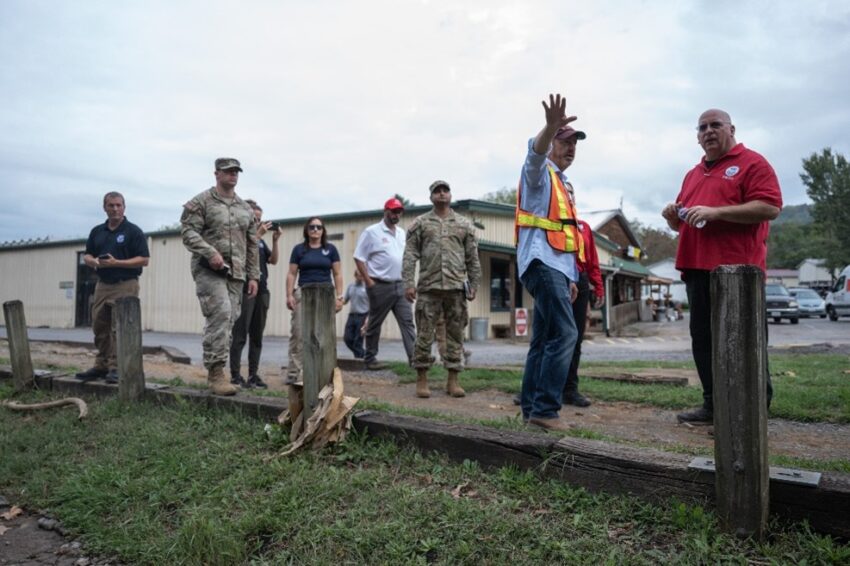From FEMA: “An official points to damage from Hurricane Helene (in Washington County, Va.,, speaking with FEMA Federal Coordinating Officer Timothy Pheil. Officials surveyed damage with staff from the Virginia Department of Emergency Management, Virginia National Guard, U.S. Army Corps of Engineers and FEMA.” (Nicholas Monteleone/ FEMA)
In the wake of deadly flooding in central Texas and New Mexico that claimed over 100 lives with nearly 200 still missing, scrutiny of the Federal Emergency Management Agency (FEMA), which provides disaster recovery services and funding, has mounted.
Before the floods, the federal government had announced plans to eliminate or remake the agency and is now reviewing its procedures, funding, and execution of agency missions, a process in which Virginia’s governor is taking an active role.
Virginia agencies assist Texas flood recovery, share how state prepares for dangerous weather events
As part of an executive order from President Donald Trump, the FEMA Review Council is analyzing the emergency response agency for potential changes or reductions. Virginia Gov. Glenn Youngkin was appointed to the council and now serves on a subcommittee that will report on the roles of localities and other agencies outside of FEMA when it comes to disaster response.
The goal is to create better communication and to put more of the recovery responsibilities on the shoulders of the states.
“We will be receiving inputs from governors, from local leaders, from emergency response personnel, and, of course, from the review council itself,” Youngkin said. “I think we will be able to chart a very clear delineation of the way things work today,” Youngkin added, noting the “deep challenges” of FEMA’s current system and the group’s goal to “shift responsibility to the states and therefore move FEMA from being a supplant role into a support role.”
Traditionally before disasters, FEMA promotes emergency preparedness and provides the National Flood Insurance Program. They also help stage resources in areas where a known storm such as a hurricane is headed towards.
During an event that received a presidential disaster declaration, the agency helps provide recovery centers to disseminate resources as well as funding application locations across the affected areas. The agency works with local and state resources to aid affected communities in the immediate and long-term aftermath of a disaster.
Following Hurricane Helene last year, Virginia was awarded over $18 million from FEMA for individual and household programs. However, low-income families did not often meet the threshold for FEMA funding, leaving them in the lurch when trying to build back their lives. The agency has drawn the ire of Trump and other Republicans, despite some analysts and state officials framing FEMA as a critical resource whose assistance states would likely not be able to replicate on their own.
“Despite obligating nearly $30 billion in disaster aid each of the past three years, FEMA has managed to leave vulnerable Americans without the resources or support they need when they need it most,” Trump said in his executive order establishing the review council.
Youngkin said in his statements to the council on Wednesday that during the response to devastating flooding it was unclear what FEMA would provide in addition to other federal agencies.
“How do we move forward with haste in order to meet our citizens’ needs when we don’t really even know how much the resources are going to be to provide the answers to the basic needs of housing, food, and recovery. This is the work that we are undertaking,” Youngkin said.
FEMA has had to deal with a growing number of high-dollar disasters across the country leading to strained services and slower response times. That is on top of reductions in funding from the federal government under the second Trump administration, which have impacted flood resiliency projects, National Weather Service staffing, and other programs in Virginia.
As mandated by the executive order, the council’s final report will include a review of FEMA’s disaster response in the last four years, comparing FEMA’s response to how local and state agencies responded to the same disasters, what programs were in place before FEMA, and how the agency can be more of a support than the main response to disasters.
The order does not explicitly state when a final report is due, and a date wasn’t mentioned in Wednesday’s meeting, but the council is only ordered to exist for one year.
YOU MAKE OUR WORK POSSIBLE.
Click this link for the original source of this article.
Author: Shannon Heckt
This content is courtesy of, and owned and copyrighted by, https://www.virginiamercury.com and its author. This content is made available by use of the public RSS feed offered by the host site and is used for educational purposes only. If you are the author or represent the host site and would like this content removed now and in the future, please contact USSANews.com using the email address in the Contact page found in the website menu.








